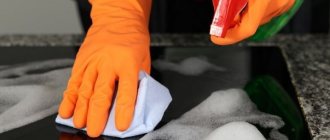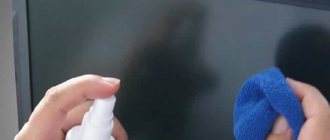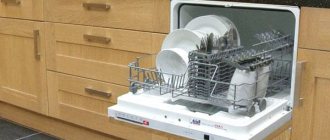Manufacturers advise cleaning your car about once a month. But this is a general recommendation. In your case, you may need to wash the device more often or less often. It depends on how exactly you are used to using the device.
Please note that the car gets dirty faster if:
- you turn it on once a day or more often;
- forget to leave the door open after washing (in this case, the internal elements of the machine take longer to dry and mold may appear on them);
- your water is too hard, but you forget to add special softening salt for the dishwasher to the compartment provided for this;
- load very dirty dishes - with burnt food, congealed fat, dried pieces of dough;
- run the wash at a low water temperature (for example, to save energy);
- are accustomed to using only gentle detergents that are simply not capable of removing serious stains;
- Place dishes that are not dishwasher safe, such as disposable or wooden ones, into the chamber.
However, even under such harsh operating conditions, the machine is able to remain clean for a long time. You can determine when it’s time to wash it based on certain signs.
How to know when it's time to clean your dishwasher
Here are a few main symptoms:
- Unpleasant odor from the working chamber.
- Poor dishwashing: plates, pots, and cups end up with whitish water stains or a greasy residue.
- Food particles are observed inside the chamber or on dishes removed from it.
- Rust and mineral deposits are visible on the internal surfaces of the tank.
- An indelible coating is visible on the filter and water spray blades.
- You notice that the water drains slower than usual or begins to leak.
If any of these signs appear, the car clearly needs a comprehensive cleaning. Be consistent.
How to Clean Dishwasher Baskets
Photo: Vladyslav Lehir / Shutterstock
Baskets are those lattice trays on which dishes are placed. Food debris, especially in the form of long fibers, and fat can accumulate on them.
What you will need
- Latex gloves.
- Soft microfiber cloths.
- Sponge for washing dishes.
- An old toothbrush with soft bristles.
- Cleaning solution. The easiest way to prepare it is to dissolve a couple of tablespoons of dishwashing liquid in a liter of warm water.
- Pure water.
What to do
Remove the baskets from the guides, if possible, and soak them in the cleaning solution for a few minutes. Fixed elements will have to be washed directly in the car, pushing them out as far as possible.
Remove any large food debris. Then use a sponge to thoroughly wipe the grates on all sides. Use a toothbrush to clean hard-to-reach areas in the crooks of the baskets.
Shot: @Miss Clean / YouTube
Rinse the baskets with clean water. Wipe with tissues to remove excess moisture. Reinstall the parts if you removed them.
Removing scale using folk remedies
If you have hard water, you should periodically remove hard deposits with professional cleaning solutions or powders. You can descale your dishwasher using folk remedies that every housewife can find. Here it is important not to overdo it with the exposure time of the selected drug so that it does not damage the parts of the device. Most often, the rubber seal suffers from aggressive agents, so any agent should not remain inside the device for more than 1-2 hours.
Citric acid
If you clean your dishwasher with citric acid, you can get rid of not only scale, but also mold, rust and unpleasant odors. The powder is poured directly into the detergent compartment and an intensive washing cycle is started. How much acid to pour is determined based on the degree of contamination of the device. If there is a lot of scale, take 300-400 g of the product; if it has just begun to form, 200-300 g will be enough.
Vinegar
To clean the dishwasher, use 9% table vinegar. The essence can damage the rubber seals of the device, so it can only be used in diluted form. The basket is pulled out, 500 ml of product is poured into the lower compartment and the device is set to washing mode at a temperature not lower than +60°C. After the water and vinegar have warmed up, pause the machine and wait for 40 to 60 minutes. The program is then completed.
Borax for scale
Borax (sodium borate) powder is available at pharmacies. To obtain a sanitary product, it is diluted with water in a 1:1 ratio. The paste is applied to all working surfaces, hard-to-reach areas, rubber seals and left for 30 minutes. Dilute 2 tbsp in a glass of water. l. powder, pour the solution into the detergent compartment and turn on the machine for a full operating cycle.
Soda and peroxide
To clean your Bosch machine yourself, baking soda in combination with hydrogen peroxide is also suitable. Mix 1 pack of soda with 1 bottle of peroxide and add 5-7 drops of essential oil if desired. The pulp is packaged in a plastic bag, shaped into a ball and placed in the freezer for 1-2 hours. Then the product is freed from the film, placed in a basket for dishes and set to a long washing mode at high temperature.
How to clean dishwasher filters
Some manufacturers recommend cleaning these elements after each dishwashing. The fact is that the filter system traps food particles to prevent them from clogging the drain. If this debris is not removed promptly, it decomposes and can cause an unpleasant odor. In addition, dirty filters make it difficult to drain water from the machine.
What you will need
- Latex gloves.
- Soft microfiber cloths.
- Screwdriver - optional.
- Sponge.
- Dishwashing liquid.
What to do
Unplug the dishwasher and close the water supply valve.
Pull out the strainer. It is usually located on the bottom panel of the dishwasher, next to the water spray blades.
Shot: @Oleg Home&Family / YouTube
If you have a modern dishwasher, removing the filter will not be difficult: just pull it up a little or unscrew it. On older models, you may need to use a screwdriver.
Shot: @Oleg Home&Family / YouTube
Inspect the filter for contamination. Remove any larger pieces of food and other debris, such as pieces of plastic utensils.
Rinse the part under warm running water. If the parts have a lot of grease, use a sponge and dishwashing detergent.
Blot the clean filter with an absorbent cloth to remove excess moisture and reinstall. Make sure that the marking arrows on the bottom of the dishwasher and on one side of the part point to each other after installation.
Cleaning the heating element from scale
Scale is the main enemy of the heating element. When heated, calcium and magnesium salts contained in water settle on the heating element. If scale is not removed in a timely manner, sooner or later a malfunction will occur; moreover, a heating element with a layer of scale consumes more electricity.
Special means
It is best to clean PMM from lime deposits using special products. Their use is allowed strictly according to the instructions, without violating the proportions. The following can be used:
- “Finish” is an affordable and effective remedy. You can use it only once a month. Available in liquid form in 250 ml bottles. 1 bottle is designed for 1 cleaning. Similar products: Somat, Calgonit Fusion Power, Top House, etc.
- Descaling tablets for coffee machines. Usually one piece is enough, place it in the detergent compartment and run the cycle without dishes. Before purchasing such tablets, make sure that the manufacturer is reliable and compatible with metals.
- "Antiscale". This powder is sold in all departments of household chemicals. Use it occasionally to prevent limescale during your dishwashing cycle, but not too often. Traces of this product remain on the dishes, so additional rinsing is required.
Advice! To prevent scale formation and improve the cleaning properties of your machine, do not forget to use special salt for dishwashers; it softens the water and prevents the formation of deposits.
Lemon acid
Citric acid is a universal assistant in cleaning any kitchen utensils and appliances, PMM is no exception.
To clean it from scale, you need to determine the extent of the problem. Minor scale will be removed by 200 g of acid, and if it is already clearly noticeable, then 2 times more will be required.
Lemon crystals need to be poured into the cleaning agent compartment and run the cycle with the highest temperature. After completion, you need to run an additional rinse. This will help remove any acid particles.
Important! Experts warn about the dangers of using citric acid, because... This substance can harm the rubber seals of the car.
An alternative option for descaling is to use vinegar. Pour it into a cup, add 2 tbsp. l. soda, place it on the mug shelf and run the standard PMM mode.
How to clean dishwasher spray arms
Sprayers, or spray arms, ensure the flow and uniform distribution of water inside the dishwasher chamber. If they are clogged, the dishes will not be washed properly: stains and greasy marks will remain on them.
What you will need
- Latex gloves.
- Tweezers or toothpick.
- Microfiber cloths.
- Sponge.
What to do
Carefully inspect the openings (nozzles) of the spray arms from which water flows for contamination.
Shot: @Oleg Home&Family / YouTube
If you see dirt or food debris, try removing it with tweezers or a toothpick. But under no circumstances push debris into the nozzles!
If the parts are heavily soiled, remove the lower and upper nozzles as indicated in the machine instructions. Most often, the upper blade unscrews, and the lower one can be removed by simply gently pulling it up.
Rinse parts under warm running water, using a sponge if necessary. Then wipe the blades with napkins and put them in place.
How to clean seals and dead spots in your dishwasher
Grease, food debris and other debris accumulate not only on filters and open surfaces of the device, but also in hard-to-reach places. For example, on the rubber gaskets between the door and the body.
In addition, debris can get into the lower part of the door - the so-called dead zone, where water does not penetrate during washing. This may cause an unpleasant odor.
What you will need
- Latex gloves.
- Dishwashing liquid.
- Sponge.
- Toothbrush with soft bristles.
- Microfiber cloths.
- Water.
What to do
Carefully inspect the seals and the bottom of the door. Remove large, visible debris.
Then wipe the elements with a sponge with detergent applied to it. If dirt is difficult to reach, use a toothbrush.
Wash the seals and the “dead zone” with a cloth soaked in clean water. Wipe dry.
Mechanical cleaning stages
Mechanical removal of dirt and scale is the key to long service life not only for the dishwasher, but also for other household appliances: washing machine, electric kettle, iron, etc. You can tell that the appliance needs cleaning by changes in its operation: the machine starts make noise, vibrate, draw water poorly. But you shouldn’t wait for these signs to appear, since it’s easier to prevent a breakdown than to pay for expensive repairs later.
The dishwasher is cleaned automatically in those models that have a special mode. However, in unfavorable operating conditions (hard water, use of low-quality detergents, etc.), this option does not provide complete care. If the equipment is clogged, proceed to manual cleaning.
Before cleaning the PMM at home, it is disconnected from the power supply. To wash the body, use brushes, soft cloths or sponges and non-aggressive detergents. Hands must be protected with rubber gloves.
Washing the drain and fill filter
All dishwasher models are equipped with 2 water purification filters. The filling filter cleans the tap water entering the device from sand, metal salts and large fractions of debris. The drain filter purifies the waste water from the machine before it goes down the drain.
The drain filter located at the bottom of the washing chamber is recommended by equipment manufacturers to be cleared of accumulated waste after each washing cycle. If the machine is used from time to time, the filter unit must be cleaned at least once every 2 weeks.
It is easy to find the filter if you remove all the dish baskets from the unit. It is located at the bottom of the washing chamber and looks like a depressed cup. Remove it by unscrewing it clockwise or simply pulling it out of the socket. Before cleaning the dishwasher filter, it is disassembled.
The parts are washed with a brush and a non-aggressive detergent: laundry soap, soda, dish gel. You can pre-soak the disassembled parts in warm water with one of the cleaning products. A dry, clean filter is installed in place, guided by the marks on the pan and housing. In case of difficulties, it is recommended to use the instructions so as not to break the filter and grille. The more often the filter is washed, the easier its subsequent cleaning.
The inlet filter clogs less often, but its sanitary condition cannot be ignored, especially if the tap water is highly hard. To clean the filter, perform the following steps:
- Disconnect the machine from the network.
- Unscrew the inlet hose.
- Remove the filter from the slot.
- Rinse it under running water.
- Place the part in place. After this, rotate the hose.
Before you clean out a clog from your machine, you should look at the owner's manual. In it, the manufacturer indicates the exact recommendations applicable to the model it produces.
Checking and cleaning sprinklers
A spray system clogged with fine particles can also cause dishwasher failure. Small grains of sand and calcium salts pass through the cells of the inlet filter and settle on the sprinklers, rendering them inoperable.
To clear the blockage, the cleaning element is disconnected and disassembled. To do this, unscrew the bolt on which the sprayer is attached and remove it. The nozzles are cleaned using a piece of thin wire held in pliers. The part is washed in the sink under strong water pressure to wash away any remaining dirt.
Then check the condition of the bracket holding the sprinkler. To do this, it is removed and inspected for the formation of scale that impedes the water supply. Using a wire, carefully remove all solid deposits from the element.
After the work has been done, apply a stream of water and evaluate the result obtained. If the water sprays freely, begin reassembling the structure. Make sure that the nozzles rotate without interference or effort.
Cleaning the housing and seals
It is advisable to wipe the inner chamber containing the dish baskets and seals dry after each washing cycle. It is recommended to periodically clean the dishwasher from odors and dirt using disinfectants. The joints and the lower part of the door, where food debris most often settle, require increased attention. You can remove dirt and grease with a damp cloth or soap solution.
The baskets are pre-soaked in cleaning agent to make it easier to remove dried dirt. Stiff, non-metallic brushes will help remove grease from your dishwasher. If the device has a self-cleaning system, you can skip this point.
When cleaning equipment at home, you need to choose the right detergent and disinfectant. Rubber bands should not be washed with chlorine bleach or concentrated vinegar essence: they may crack and harden. Reduced elasticity of seals leads to water leaks during operation, so mild detergents are used to care for them.











